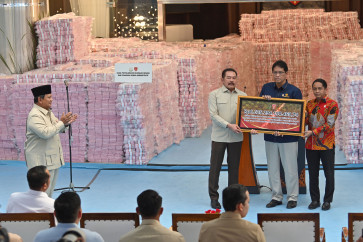Popular Reads
Top Results
Can't find what you're looking for?
View all search resultsPopular Reads
Top Results
Can't find what you're looking for?
View all search resultsLand subsidence prompts calls for audits
Experts warned building managers to beware of cracks and lopsided structures in buildings in areas greatly affected by land subsidence as this could indicate the need of further reinforcement
Change text size
Gift Premium Articles
to Anyone
E
xperts warned building managers to beware of cracks and lopsided structures in buildings in areas greatly affected by land subsidence as this could indicate the need of further reinforcement.
They also called for audits into the construction work.
“If cracks are found, the structures must injected with epoxy,” Puguh Winanto, a technical structure expert at the Assessment and Application of Technology Agency (BPPT), said.
Puguh said cracks of widths between 0.2 millimeter and 0.4 millimeter were especially concerning.
A study recently found that massive development in the capital has caused Jakarta to sink up to 10 centimeters per year due to extensive ground water extraction and pressure from high-rise buildings in the city.
The highest rate of subsidence was recorded in coastal areas in North Jakarta including Muara Kapuk and Ancol, where extensive development had increased pressure on the relatively young and porous soil beneath.
As for lopsided buildings, Puguh said the BPPT had not ascertained the degree of tilt that could be considered dangerous as there were no studies on the matter.
“A direct effect might be an uncomfortable sensation inside the building,” he said.
However, Puguh underlined that subsidence would not contribute significantly to damage to buildings.
“If the piling are embedded in hard and solid rock, then subsidence would have no relatively significant impact,” he said.
As long as the piles, floor and girder of the main building were not cracked, the building was relatively safe, Puguh said.
A former member of high-rise buildings investigation division at the BPPT, Mulyo Haris Pradono, also said that high-rise buildings were normally built on pilings implanted in solid rock up to 30 meters beneath the ground.
“So they are strong enough to support the buildings and will not be affected by subsidence,” he told The Jakarta Post.
BPPT’s head of disaster mitigation technology, Sutopo Purwo Nugroho, said the agency had the technology and human resources to audit the structural integrity of high-rise buildings.
Unfortunately, he said, no building managers or even the city administration, were interested in using the technology.
“We have sent proposals to the city administration and some building owners but none of them responded,” he said.
He said he assumed it might be because of the prohibitively high cost of the audit.
“An audit can cost up to Rp 200 million [US$22,000],” he said.
He said an audit was a one-time evaluation and only needed to be repeated following a strong earthquake.
As long as the piles, floor and girder of the main building were not cracked, the building was relatively safe.










